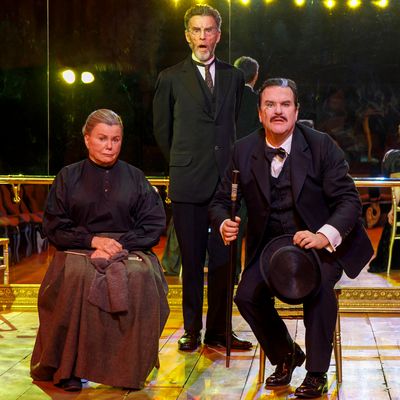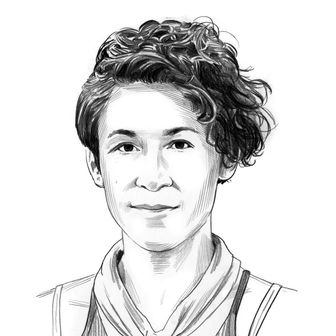
Historical geniuses are tricky beasts to dramatize. Last year, Scott Carter’s attempt to revive the corpses of Dickens, Tolstoy, and Thomas Jefferson fell flat at Primary Stages. Now, in the world premiere of Fire and Air at Classic Stage Company, Terrence McNally is encountering his own set of difficulties in conjuring up an even more histrionic spirit, albeit one that might be slightly less well known to Americans. Sergei Diaghilev changed the face of art with his creation of the Ballets Russes in Paris in 1909. A dashing, tempestuous Russian émigré constantly on the verge of bankruptcy, Diaghilev dabbled in singing and composition as a young man in the aristocratic, pre-revolutionary intellectual circles of St. Petersburg, but with no success. He openly described himself as “someone afflicted with a complete lack of talent,” but he knew where his strengths lay. In McNally’s words, his artists were his talent.
Diaghilev was an unparalleled impresario, a producer who brought together geniuses like moths to a halogen lamp. Between 1909 and his death in 1929, the Ballets Russes employed the likes of Stravinsky, Debussy, Prokofiev, Picasso, Matisse, Kandinsky, Léon Bakst, and even Coco Chanel. The company rocketed the young dancer — and Diaghilev’s lover — Vaslav Nijinsky to superstardom. It sparked scandal with Nijinsky’s sensuous choreography for Debussy’s Afternoon of a Faun, followed by actual riots in the audience during the tradition-shattering premiere of Stravinsky’s The Rite of Spring. Under Diaghilev’s exacting eye, it wove music, dance, and visual art together and pushed all three gloriously, shockingly into the modern age — all while teetering on the brink of financial ruin and serving as a hotbed for myriad backstage trysts and betrayals. C’est dramatique!
So why is McNally’s Fire and Air such leaden drama? Under the direction of CSC artistic director John Doyle, the play almost never achieves the loft and ferocity implied by its titular elements. Though McNally is a writer of far more sensitivity than Scott Carter, he too becomes mired in the challenges of bringing to life a larger-than-life figure. How can a writer humanize someone like Diaghilev — or Nijinsky, for that matter — while simultaneously conveying the myth? How can we retain connection onstage with a human being whose Wikipedia page might fascinate us, but whose appearance in the flesh struggles to transcend the hoariest clichés of Troubled Genius? Peter Shaffer got away with it in Amadeus, but he was wily: First, he tucked the eponymous genius away in a supporting role and smartly dedicated his play to a fictionalized exploration of the lesser composer Salieri’s jealousy. It’s easier for most of us to identify with a cancerous inferiority complex than with the men who bestride the world like colossi. Second, Shaffer let us hear Mozart’s music.
That’s where Fire and Air first starts to stumble. Unlike the music of Mozart, the live performances of the Ballets Russes are lost to time. McNally even dedicates a sequence in his play to Diaghilev destroying a pirated film reel of one of the company’s ballets (the real Diaghilev never allowed their work to be filmed). We’ve got still images, utterly striking ones, of Vaslav Nijinsky, but we’ve got to take the heartstopping grace and virility of his actual dancing on faith. You can cast a beautiful, talented actor — as Doyle has, in James Cusati-Moyer— but after two hours of hearing about his character’s genius without getting to witness a performance of it, that faith is going to wear thin. Even in a “behind the scenes” play, a director would be wise to take a page out of Diaghilev’s book — to cook up some ingenious dramatic solution to the problem of showing us something remarkable, not simply telling us about it. “‘Astonish me,’ you said,” Cusati-Moyer’s Nijinsky tells the hungry-eyed Diaghilev, played with no shortage of impassioned gusto by Douglas Hodge. But Doyle doesn’t astonish us. We barely even get to hear the music that made the Ballets Russes’ performances immortal — save for a quietly repeated refrain from Debussy’s Faun and a distressingly short snippet of The Rite of Spring (the mostly recessive sound design, which I longed for much more of, is by Matt Stine).
Not only does Doyle shy away from evoking the marvels inherent in the play’s material, he also fails to add drive and punctuation to McNally’s meandering text. Fire and Air is a kind of requiem play: it begins with an evocation of Diaghilev’s death in Venice in 1929. It’s not a bad opening image — the man who, like Cleopatra, had fire and air and immortal longings in him, died of diabetes in a drowning city — and, it’s not too hard to guess, the play will ultimately come back around to it. In the meantime, we hop amongst times and locations — from St. Petersburg to Paris, Venice to Monte Carlo, from hotel room to rehearsal studio to backstage, from memory to the present moment.
These fluid internal shifts aren’t problematic in and of themselves; in fact, in another production they might render McNally’s play much more dynamic, untrammeled as it is by total naturalism. But Doyle gives us so little sense of each transition, both atmospherically and in his work with the actors, that the play begins to feel like one long, rambling scene. We’re constantly catching up with the characters (“Oh, I guess we’re in Monte Carlo now?”), rather than leaping alongside them, which creates a sense of heaviness where there should be dexterity. Doyle also designed the set, according to his customary love of spare spaces garnished with a few elegant if predictable elements: here, a fleet of hanging light bulbs, two large gilded mirrors that suggest a dance studio, and several gold chairs. The spareness isn’t a fault — Shakespeare’s stages were empty — but the failure to make it fully evocative is. There’s no muse of fire at work on our imaginations here.
As for the man at the heart of the myth, Douglas Hodge throws himself into Diaghilev’s gale-force mood swings, his flights of grandiosity and his blubbering dives into despair, with an intensity that’s both admirable in its tenacity and, at times, borderline sloppy. He’s a formidable actor, with a Tony for his performance as Albin in the 2010 revival of La Cage aux Folles — and indeed, Diaghilev, with his love for sparkles and bangles and his defiant sense of self, would be right at home belting out “I Am What I Am.” But Hodge is often pushing here. “Do I exhaust you with my enthusiasm?” he demands of his more discreet cousin Dmitry (played in a restrained and at times moving performance by John Glover). Dima’s answer is yes — and unfortunately, so is ours. Though Hodge is working bravely, he’s not always working with focus: his energy feels scattershot, as if he’s strafing rather than sniping. That means certain moments are bound to hit, and some do, but nothing feels successfully targeted straight through the heart.
Furthermore, he’s surrounded by an ensemble of supporting actors who are allowed to do very little but … support. Dima loves his cousin and fusses over his finances. Dunya (Marsha Mason in a sympathetic performance as Diaghilev’s long-suffering nanny) loves him and fusses over his health, his diet, his moods. His best friend, the glamorous arts patron Misia Sert, fusses over his heart, and of course, his genius. “I thought you and your set were trivial,” says the regal Marin Mazzie as Mme. Sert to Dima. “We all were. He’s the only one who wasn’t.” Do yourself a favor and check out Misia Sert’s Wikipedia page: The woman was a total badass. She deserves her own play, but here she’s written to waft through Diaghilev’s extraordinary life, worshipping him like everyone else, occasionally making comments like “I have a mind and a will as ferocious as yours,” so that we’ll all know that McNally knows she’s worth more time than he’s giving her. More telling where we want showing.
Mme. Sert, Dima, Dunya, and the beautiful boys, Nijinsky and Massine (the up-and-comer who ultimately took Nijinksy’s place in the Ballets Russe): All are simply planets orbiting Diaghilev’s sun. Perhaps such a structure seemed unavoidable, but the few moments McNally pushes against it produce some of Fire and Air’s best scenes. When Nijinsky — now out of Diaghilev’s favor and the company after his sudden marriage to his own creepy superfan, Romola de Pulszky —enters into an imagined dialogue with Massine (Jay Armstrong Johnson in a tight-lipped, tight-abbed performance as the ambitious new kid who might not be entirely prepared to give everything to his new boss), the play wakes up. “This isn’t really happening, you know,” Nijinsky tells his replacement in a sinister purr as the pair exchange questions, secrets, and warnings — two alpha pups cautiously circling each other. Cusati-Moyer comes into his own, as his Nijinsky is finally allowed to transcend the sullen, unstable prodigy stereotype. Call it a flaw or a feature, but Fire and Air often shines brightest, and floats most gracefully, when it sidesteps the overwrought convulsions of its own central colossus.
Fire and Air is at Classic Stage Company through February 25.


